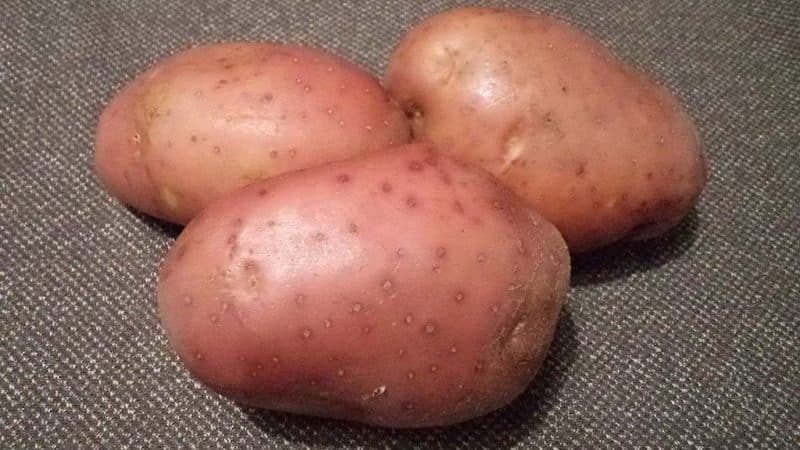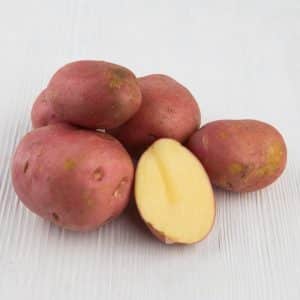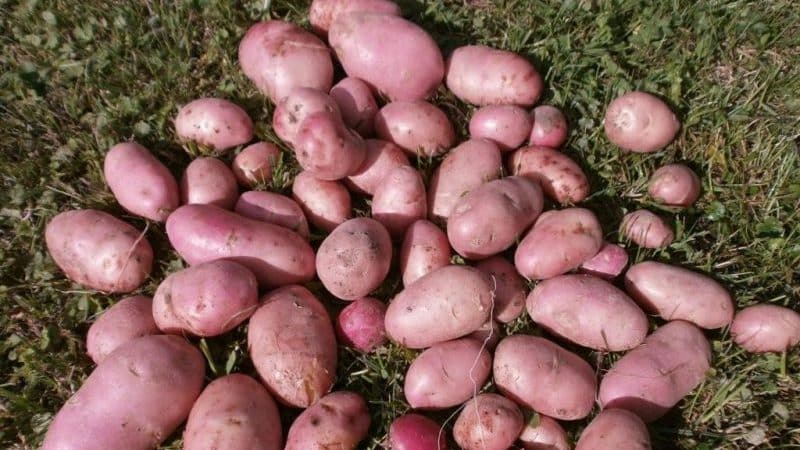High-yielding, mid-late potato variety “Manifest” with red tubers
The best potato varieties are easy to grow, not prone to disease, and still produce a rich harvest of tasty tubers. The Manifesto variety of Belarusian selection is ideally suited to these characteristics. The culture is distinguished by its long shelf life, excellent taste and resistance to the most common nightshade diseases.
Description of the variety
Manifesto potatoes are grown everywhere by many farmers in the country. It has become widespread due to consistently high yields.

Origin and development
The manifesto was developed by Belarusian breeders in 2011 and entered into the State Register of the Russian Federation in 2014. This is a mid-early table potato variety recommended for growing in temperate and warm climates. The crop is valued for its high yield, long-term storage, resistance to mechanical damage and various diseases. Cultivated in gardens and on an industrial scale.
Compound
Potatoes contain a lot of vitamins, macro- and microelements. Nutritional value per 100 g:
- 75–80 kcal;
- 1.8–2 g protein;
- 0.3 g fat;
- 16-17 g carbohydrates;
- 15.6 g starch.
Potato tubers are rich in vitamins, macro- and microelements necessary for the human body. The table shows the content of substances per 100 g of product:
| Vitamins | Macronutrients | Microelements | ||||||
| Name | Amount (mg) | % of daily value | Name | Amount (mg) | % of daily value | Name | Amount (mg) | % of daily value |
| B1 | 0,03–0,12 | 8 | Potassium | 421–568 | 23 | Iron | 0,3–4,9 | 15,5 |
| B2 | 0,02–0,12 | 4 | Sodium | 4–11 | 0,5 | Iodine | 0,003–0,005 | 3 |
| B5 | 0,3-0,4 | 6 | Phosphorus | 40–90 | 2,5 | Zinc | 0,2–0,5 | 2,5 |
| B6 | 0,14–0,3 | 15 | Calcium | 5–10 | 1 | Copper | 0,03–0,2 | 14 |
| B9 | 0,02–0,06 | 10,5 | Magnesium | 11–28 | 6 | Manganese | 0,13–0,44 | 16 |
| C | 20–26 | 24 | Sulfur | 32 | 3,2 | Bor | 0,12 | 164 |
| E | 0,05–0,2 | 1 | Chlorine | 58 | 3 | Fluorine | 0,03 | 1 |
| PP | 1,2–2,4 | 10,5 | Silicon | 50 | 167 | Vanadium | 0,15 | 373 |
| K | 0,02 | 13,3 | Lithium | 0,08 | 77 | |||
In addition, 100 g of vegetables contain up to 4% of the daily requirement of essential and up to 2% of non-essential amino acids.
Ripening time and yield
The variety is mid-early: from the moment the tubers are planted until the harvest, 90–110 days pass, depending on the region of cultivation and weather conditions.
Productivity is high: 170–370 c/ha. Yield indicators vary depending on climatic conditions. The maximum result was noted in the Tula region, where 458 centners of potatoes were grown from 1 hectare of land.
On average, 13–15 tubers are obtained from one bush. For their own use, they plant up to 500 pieces per hundred square meters of land.
Disease resistance
Manifest is resistant to potato blight, banded mosaic, leaf curl, black leg, and golden potato cyst nematode. Slightly susceptible to late blight and common scab.
Characteristics of bushes and tubers
The bushes are erect, 50–55 cm high. The leaves are glossy, rich emerald green. The flowers are lilac in color and fall off quickly, within 8–10 days. Powerful root system.
The tubers are large in size, the average weight of one is 90–130 g, sometimes reaching 150 g. The shape is oblong with rounded edges. The skin is dense, there are small reddish eyes on the surface. The color of the peel is dark pink, the flesh is yellowish with a slight amber tint. The starch content in each tuber is 13–15%. At cooking the potatoes retain their structure.
What regions is it suitable for?
Planting of the crop begins at the end of May.To fully ripen, the variety requires stable warm weather, so it is grown in the Central, Northwestern, and Volga-Vyatka regions of Russia. The manifesto is well cultivated in the Yaroslavl, Kaluga, and Vladimir regions. High yields are achieved in the Krasnodar region.
Advantages and disadvantages of the variety
Main advantages of the Manifesto:
- high yield and keeping quality;

- tolerates long-term transportation well;
- does not deteriorate due to mechanical damage;
- tubers are rich in nutrients and vitamins;
- good presentation and excellent taste of vegetables;
- the tubers do not overcook and are suitable for preparing various culinary dishes;
- At harvest, the rejection rate is very low.
Disadvantages of the variety:
- requires high-quality nutritious soil;
- With improper cultivation techniques, the crop becomes smaller.
Manifest is more often affected by potato moth than other varieties.
Features of cultivation
The time of growth and the quality of the harvest depend on timely landings and compliance with agricultural techniques for growing crops.
Preparing for landing
Tubers begin to be prepared 20–25 days before planting. First, healthy specimens are selected without damage, approximately the same size of 5-6 cm. The vegetables are placed in a spacious container in 3 layers. The container is placed in a warm, bright place and left for the tubers to germinate. After the sprouts appear, the planting material is re-inspected.
Important! For planting, leave the tubers on which several strong, dense sprouts have formed.
Vegetables are treated with a weak blue solution of copper sulfate or a solution of boric acid to prevent fungal infections.
The crop is also planted with seeds.To do this, they are first germinated and then hardened in the refrigerator. After this, they are planted in containers with soil (1 part turf soil and 3 parts peat). The seeds are placed in rows at intervals of 8-9 cm, and a thin layer of sand is poured on top. The soil is carefully watered and covered with a transparent film. Ventilate the container regularly.
Soil requirements
The Manifest variety grows well both in open ground and in greenhouse conditions, on light, breathable soil with an average level of acidity. Chernozem, sierozem, leached chernozem, and chestnut soil are ideal. The soil is prepared after the next harvest. When digging, add compost, peat, and humus. In spring, fertilize with complex products containing nitrogen, potassium, and phosphorus in equal quantities.
Planting dates and scheme
Planting takes place in mid-May. The prepared material is planted only in warm soil, when it warms up to +8...+10°C.
Attention! Planting dates vary depending on the climatic conditions of the region.
For the Manifesto, breeder-developers recommend ridge technology for planting tubers. It consists of several stages:
- When loosening the soil, make furrows 9-10 cm deep. Keep 60-70 cm between them.
- The sprouted tubers are carefully placed in the grooves, leaving a gap of 28–30 cm between the planting material. This is done carefully so as not to break off the sprouts. The furrows are sprinkled with loose soil on top, forming ridges 13–15 cm in height.
- Gradually add soil to the ridge every week until it reaches 28–30 cm.
This growing technology promotes earlier emergence of seedlings, 12–14 days earlier than with conventional planting.When using this method, the soil always remains loose and breathable. Yields increase by 30–40%.
Nuances of care
Before planting, the soil is aerated to enrich it with oxygen. During the growing period, the soil is mulched and regularly loosened.
For free growth of potatoes and movement during crop care, leave at least 60–70 cm between the bushes.
Watering mode
The culture does not require frequent watering. The first time it is moistened during planting of sprouted tubers, the second time - when the tops stretch to 13–15 cm. The next watering is carried out during flowering. During this period, drip irrigation is well suited to distribute water evenly throughout the beds. After flowering ends, the crop is moistened for the last time.
Important! Experienced gardeners do not recommend watering after the crop has flowered: this increases the risk of late blight.
After each irrigation, hilling is carried out so that the ridges do not sink and for better aeration of the soil.
Feeding
When planting tubers, add wood ash (1 tablespoon each) to the holes. It contains potassium, phosphorus, calcium, iron, magnesium, sulfur, zinc, and protects plants from blackleg.
When the tops grow to 10–12 cm, apply a product consisting of mineral and organic fertilizers. A mixture of 1 liter of manure diluted in a bucket of water with the addition of 15 g of superphosphate gives a good result. The nutritional composition is applied at the root.
It is undesirable to use nitrogen fertilizers to feed potatoes: they promote rapid growth of tops to the detriment of tubers.
Weeding and hilling
Potatoes must be weeded. For the first time when seedlings emerge, 20 days after planting the tubers.When weeds grow rapidly, do not wait for young tops to appear, but remove the weeds immediately. The second weeding is carried out when the tops reach 30 cm in height.
Important! During weeding, the soil is loosened for soil aeration and better growth of tubers. The soil is also loosened after watering or rain.
Hilling is carried out every 10 days, combined with weeding and loosening. Using a hoe, they rake the soil up to the tops of the tops, keeping it upright. At the same time, inspect the bushes and remove damaged and dry leaves. The procedure helps remove weeds and supplies the soil with oxygen.
Disease and pest control
Potatoes often suffer from late blight. The disease affects the tops, then spreads to the tubers. Small dark brown spots appear on the leaves and stems and quickly enlarge. As a result, the leaves wither, turn black and dry out.
At the first signs of late blight, the bushes are treated with substances containing copper: copper sulfate solution, Bordeaux mixture.
For prevention, lime is used, a solution of which is sprayed on the ground before planting the crop.
Common pests that destroy vegetables: potato moth and Colorado potato beetle. Biological and chemical agents are used to combat them.
Attention! Chemicals are not used when ovaries appear.
Potato moth multiplies quickly. Signs of its appearance are cobwebs and drying leaves. It is difficult to get rid of the insect; the larvae can destroy a significant part of the crop. Lepidocide and Dendrobacillin are used in pest control. Treatment is carried out until the ovaries appear.
Insecticides “Matador” and “Proteus” help get rid of the Colorado potato beetle.
Harvest and storage
Potatoes begin to be dug up in early autumn. It is important not to make a mistake with the collection start time. If you dig up the tubers ahead of time, they will not have time to form a dense layer of peel.
How and when to collect
The crop is dug up after the tops have dried by 50–60%. 14 days before this, the tops are cut off so that the tubers form a dense peel.
Attention! If you keep vegetables in the ground, this will shorten their shelf life. Such potatoes will begin to sprout quickly.
The harvest is dried in a dry room. Then they sort by size and select the tubers for planting in the new season.
Storage features and keeping quality of the variety
The tubers are placed in wooden boxes, which are left in a dark, dry and cool room with good ventilation. The temperature is maintained within +3…+5°С. Potatoes can be stored for no more than 6-7 months.
The variety has a high shelf life: about 95%.
Difficulties in growing
When cultivating potatoes, gardeners are faced with excessive growth of tops. This occurs due to excessive watering and fertilizing with nitrogen agents.
If the soil is oversaturated with moisture, the tubers rot during storage.
Advice from experienced gardeners

When harvesting, it is important not to keep it in the ground: overheated tubers wrinkle and wither. Such vegetables do not last long.
Experienced farmers advise planting potatoes at a depth of more than 15 cm. This way, potato moths will not damage the tubers.
With heavy watering, vegetables are exposed, so the sprinkling method is more suitable for bushes.
Reviews
Vegetable growers note the high yield of the crop, ease of cultivation, presentation and taste of the tubers:
Lyudmila, Saratov: “I bought Manifest potatoes for the first time. The description of the variety and the photo correspond to reality. I liked the look.I boiled it at home and it tasted very good. It doesn’t boil completely, so it’s suitable for cutting into salads.”
Sergey, Voronezh: “I was pleasantly surprised by the number of tubers from each bush: from 10 to 13 pieces. There was enough harvest for the whole winter.”
Ekaterina, Pskov: “A neighbor recommended this variety, and she also shared the tubers for planting. The characteristics of the Manifesto potato are impressive, the crop is easy to care for, and the tubers have grown to a large size. I liked the taste."
Read also:
Galaxy potato variety with excellent taste and long shelf life.
The Lasunok potato variety is loved by farmers for its ease of care and productivity.
Conclusion
Manifest potatoes are characterized by high productivity, resistance to mechanical damage during harvesting, and long-term storage. Tubers contain a large amount of vitamins and minerals that are beneficial to health. These qualities make the variety popular among gardeners and industrial farmers.